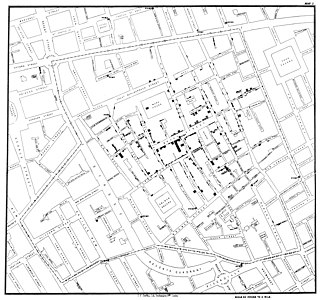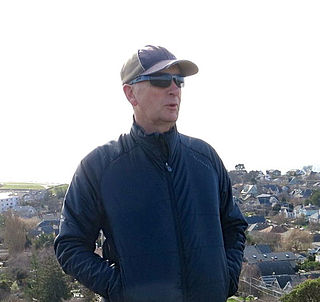Related Research Articles

Human geography or anthropogeography is the branch of geography that studies spatial relationships between human communities, cultures, economies, and their interactions with the environment, examples of which include urban sprawl and urban redevelopment. It analyzes spatial interdependencies between social interactions and the environment through qualitative and quantitative methods.

A geographer is a physical scientist, social scientist or humanist whose area of study is geography, the study of Earth's natural environment and human society, including how society and nature interacts. The Greek prefix "geo" means "earth" and the Greek suffix, "graphy", meaning "description", so a geographer is someone who studies the earth. The word "geography" is a Middle French word that is believed to have been first used in 1540.

Ethnomusicology is the study of music from the cultural and social aspects of the people who make it. It encompasses distinct theoretical and methodical approaches that emphasize cultural, social, material, cognitive, biological, and other dimensions or contexts of musical behavior, in addition to the sound component. Within musical ethnography it is the first-hand personal study of musicking as known as the act of taking part in a musical performance.
Feminist geography is a sub-discipline of human geography that applies the theories, methods, and critiques of feminism to the study of the human environment, society, and geographical space. Feminist geography emerged in the 1970s, when members of the women's movement called on academia to include women as both producers and subjects of academic work. Feminist geographers aim to incorporate positions of race, class, ability, and sexuality into the study of geography. The discipline has been subject to several controversies.

In anthropology and geography, a cultural area, cultural region, cultural sphere, or culture area refers to a geography with one relatively homogeneous human activity or complex of activities (culture). Such activities are often associated with an ethnolinguistic group and with the territory it inhabits. Specific cultures often do not limit their geographic coverage to the borders of a nation state, or to smaller subdivisions of a state.
Environmental psychology is a branch of psychology that explores the relationship between humans and the external world. It examines the way in which the natural environment and our built environments shape us as individuals. Environmental psychology emphasizes how humans change the environment and how the environment changes humans' experiences and behaviors. The field defines the term environment broadly, encompassing natural environments, social settings, built environments, learning environments, and informational environments. According to an article on APA Psychnet, environmental psychology is when a person thinks of a plan, travels to a certain place, and follows through with the plan throughout their behavior.

Yi-Fu Tuan was a Chinese-born American geographer and writer. He was one of the key figures in human geography and arguably the most important originator of humanistic geography.
Topophilia is a strong sense of place, which often becomes mixed with the sense of cultural identity among certain people and a love of certain aspects of such a place.
Behavioral geography is an approach to human geography that examines human behavior by separating it into different parts. In addition, behavioral geography is an ideology/approach in human geography that makes use of the methods and assumptions of behaviorism to determine the cognitive processes involved in an individual's perception of or response and reaction to their environment. Behavioral geographers focus on the cognitive processes underlying spatial reasoning, decision making, and behavior.

Cultural geography is a subfield within human geography. Though the first traces of the study of different nations and cultures on Earth can be dated back to ancient geographers such as Ptolemy or Strabo, cultural geography as academic study firstly emerged as an alternative to the environmental determinist theories of the early 20th century, which had believed that people and societies are controlled by the environment in which they develop. Rather than studying pre-determined regions based upon environmental classifications, cultural geography became interested in cultural landscapes. This was led by the "father of cultural geography" Carl O. Sauer of the University of California, Berkeley. As a result, cultural geography was long dominated by American writers.

Edward "Ted" Relph is a Canadian geographer, best known for the book Place and Placelessness.
Religion and geography is the study of the impact of geography, i.e. place and space, on religious belief.
Place identity or place-based identity refers to a cluster of ideas about place and identity in the fields of geography, urban planning, urban design, landscape architecture, interior design, spatial design, environmental psychology, ecocriticism and urban sociology/ecological sociology. Place identity is sometimes called urban character, neighbourhood character or local character. Place identity has become a significant issue in the last 25 years in urban planning and design. Place identity concerns the meaning and significance of places for their inhabitants and users, and how these meanings contribute to individuals' conceptualizations of self. Place identity also relates to the context of modernity, history and the politics of representation. In other words, historical determinism, which intersects historical events, social spaces and groups by gender, class, ethnicity. In this way, it explores how spaces have evolved over time by exploring the social constructs through time and the development of space, place and power. To the same extent, the politics of representation is brought into context, as the making of place identity in a community also relates to the exclusion or inclusion in a community. Through this, some have argued that place identity has become an area for social change because it gives marginalized communities agency over their own spaces. In the same respect, it is argued that place identity has also been used to intervene social change and perpetuate oppression from a top-down approach by creating segregated spaces for marginalized communities.

Geography is a field of science devoted to the study of the lands, features, inhabitants, and phenomena of Earth. Geography is an all-encompassing discipline that seeks an understanding of Earth and its human and natural complexities—not merely where objects are, but also how they have changed and come to be. While geography is specific to Earth, many concepts can be applied more broadly to other celestial bodies in the field of planetary science. Geography has been called "a bridge between natural science and social science disciplines."

The following outline is provided as an overview of and topical guide to geography:
Everyday Aesthetics is a recent subfield of philosophical aesthetics focusing on everyday events, settings and activities in which the faculty of sensibility is saliently at stake. Alexander Baumgarten established Aesthetics as a discipline and defined it as scientia cognitionis sensitivae, the science of sensory knowledge, in his foundational work Aesthetica (1750). This field has been dedicated since then to the clarification of fine arts, beauty and taste only marginally referring to the aesthetics in design, crafts, urban environments and social practice until the emergence of everyday aesthetics during the ‘90s. As other subfields like environmental aesthetics or the aesthetics of nature, everyday aesthetics also attempts to countervail aesthetics' almost exclusive focus on the philosophy of art.
Kenneth Robert Olwig is an American-born landscape geographer, specializing in the study of the Scandinavian landscape. He is best known for advocating a "substantive" understanding landscape, one that incorporates legal and other lived significances of landscape, rather than viewing it in a more purely aesthetic way. His writings include The Meanings of Landscape: Essays on Place, Space, Nature and Justice (2019), Landscape, Nature and the Body Politic (2002) and Nature's Ideological Landscape (1984)

Place attachment is the emotional bond between person and place, and one way of describing the relationship between people and spatial settings. It is highly influenced by an individual and his or her personal experiences. There is a considerable amount of research dedicated to defining what makes a place "meaningful" enough for place attachment to occur. Schroeder (1991) notably discussed the difference between "meaning" and "preference," defining meaning as "the thoughts, feelings, memories and interpretations evoked by a landscape" and preference as "the degree of liking for one landscape compared to another."

Geography of media and communication is an interdisciplinary research area bringing together human geography with media studies and communication theory. Research addressing the geography of media and communication seeks to understand how acts of communication and the systems they depend on both shape and are shaped by geographical patterns and processes. This topic addresses the prominence of certain types of communication in differing geographical areas, including how new technology allows for new types of communication for a multitude of global locations.
Qualitative geography is a subfield and methodological approach to geography focusing on the subjective and interpretive aspects of human experiences and world perceptions. It is concerned with understanding the lived experiences of individuals and groups and the social, cultural, and political contexts in which those experiences occur. Thus, qualitative geography is traditionally placed under the branch of human geography; however, technical geographers are increasingly directing their methods toward interpreting, visualizing, and understanding qualitative datasets. While qualitative geography is often viewed as the opposite of quantitative geography, the two sets of techniques are increasingly used to complement each other. Qualitative research can be employed in the scientific process to start the observation process, determine variables to include in research, validate results, and contextualize the results of quantitative research through mixed-methods approaches.
References
- ↑ Caves, R. W. (2004). Encyclopedia of the City. Routledge. p. 590. ISBN 9780415252256.
- ↑ Tuan, Yi-Fu (1977). Space and place: The perspective of experience. Minneapolis: University of Minnesota press.
- ↑ Agnew, J.A.; Duncan, J.S. (1989). The power of place: Bringing together geographical and sociological imaginations. Boston: Unwin Hyman Publishers.
- ↑ Altman, I.; Low, S.M., eds. (1992). Place attachment. Human behavior and environment: Advances in theory and research. New York: Plenum Press.
- ↑ Adams, Jennifer D. (2013). "Theorizing a Sense of Place in a Transnational Community". Children, Youth and Environments. 23 (3): 43–65. doi:10.7721/chilyoutenvi.23.3.0043. ISSN 1546-2250. JSTOR 10.7721/chilyoutenvi.23.3.0043. S2CID 149189490.
- ↑ Casey, E.S. (2001). "Between geography and philosophy: what does it mean to be in place world?". Annals of the Association of American Geographers. 91 (4): 683–693. doi:10.1111/0004-5608.00266. S2CID 56055085.
- ↑ Tuan, Yi-Fu (1980). Landscapes of Fear. Oxford: Basil Blackwell.
- ↑ Groat, L., ed. (1995). Giving places meaning: Readings in environmental psychology. San Diego: Academic Press.
- ↑ Adams, Jennifer (2016-05-26). "Sense of Place". The Nature of Cities. Retrieved 2020-03-09.
- ↑ Senses of place. Steven Feld, Keith H. Basso. Santa Fe, New Mexico. 1996. p. 11. ISBN 0-933452-94-2. OCLC 35043056.
{{cite book}}: CS1 maint: location missing publisher (link) CS1 maint: others (link) - ↑ Senses of place. Steven Feld, Keith H. Basso. Santa Fe, New Mexico. 1996. p. 4. ISBN 0-933452-94-2. OCLC 35043056.
{{cite book}}: CS1 maint: location missing publisher (link) CS1 maint: others (link) - ↑ Spretnak, C. (1997). The resurgence of the real: Body, nature and place in a hypermodern world . New York: Addison-Wesley Publishers. ISBN 9780201534191.
- ↑ Bloom, W. (1990). Personal identity, national identity and international relations. Cambridge: Cambridge University Press.
- ↑ Allen, J.; Massey, D.; Cochrane, A. (1998). Rethinking the Region. London: Routledge.
- ↑ Agnew, J. (2002). Making political geography. London: Arnold Press.
- ↑ Relph, Edward (1976). Place and Placelessness.
- ↑ Augé, Marc (1995). Non-Places: Introduction to an Anthropology of Supermodernity. New York: Verson Books.
- ↑ Michel de Certeau (2002). ""Spaces" and "places"". The Practice of Everyday Life . University of California Press. p. 117. ISBN 0-520-23699-8.
- ↑ Timotheus Vermeulen (24 April 2015). "Space is the Place". Frieze (171).
- ↑ Davis, Mike (1990). City of Quartz: Excavating the Future in Los Angeles. New York: Vintage Press, Penquin Books. ISBN 9780679738060.
- ↑ Harvey, D.C. (1993). From space to place and back again: reflections on the condition of post modernity. London: Routledge.
- ↑ Anyone's Autobiography, 1937: see Gertrude Stein.
- ↑ Measham TG (2006) Learning about environments: The significance of primal landscapes, Environmental Management 38(3), pp. 426–434
- ↑ Bixler, R. D., M. F. Floyd, and W. E. Hammitt. (2002). Environmental socialization: Quantitative tests of the childhood play hypothesis, Environment and Behavior 34(6) pp. 795–818
- ↑ Derr, V (2002). "Children's sense of place in northern New Mexico". Journal of Environmental Psychology. 22 (1–2): 125–137. doi:10.1006/jevp.2002.0252.
- ↑ Gayton (1996) Landscapes of the Interior: Re-explorations of Nature and the Human Spirit. Gabriola Island, Canada: New Society Publishers
- ↑ Measham, TG (2007) Primal Landscapes: insights for education from empirical research on ways of learning about environments, International Research in Geographical and Environmental Education 16 (4) pp. 339–350
- ↑ Felder, Maxime (September 2021). "Familiarity as a Practical Sense of Place". Sociological Theory. 39 (3): 180–199. doi:10.1177/07352751211037724. ISSN 0735-2751. S2CID 237417768.
- ↑ Kieft, J.; Bendell, J (2021). "The responsibility of communicating difficult truths about climate influenced societal disruption and collapse: an introduction to psychological research". Institute for Leadership and Sustainability (IFLAS) Occasional Papers. 7: 1–39.
- ↑ Prewitt Diaz, J.O. and Dayal, A. (2008). Sense of Place: A Model for Community Based psychosocial support programs. Australasian Journal of Disaster and Trauma Studies.
- ↑ Chigbu, U.E. (2013). "Fostering rural sense of place: the missing piece in Uturu, Nigeria". Development in Practice. 23 (2): 264–277. doi:10.1080/09614524.2013.772120. S2CID 154138597.
- ↑ Stokes, Martin. 1994. Ethnicity, Identity, and Music: The Musical Construction of Place. Oxford: Berg; Arno van der Hoeven and Erik Hitters, “The Spatial Value of Live Music: Performing, (Re)Developing and Narrating Urban Spaces,” Geoforum 117 (December 1, 2020): 154–64, https://doi.org/10.1016/j.geoforum.2020.09.016; Arno van der Hoeven and Erik Hitters, “The Social and Cultural Values of Live Music: Sustaining Urban Live Music Ecologies,” Cities 90 (July 1, 2019): 263–71, https://doi.org/10.1016/j.cities.2019.02.015.
- ↑ Stokes. Ethnicity, Identity, and Music: 3-5.
- ↑ Lipsitz, George. 1986/7. “Cruising around the Historical Bloc: Postmodernism and Popular Music in East Los Angeles.” Cultural Critique 5 (Winter 1986-1987).
- ↑ W. Benjamin et al., Illuminations: Essays and Reflections (Houghton Mifflin Harcourt, 1968): 220–22.
- ↑ Lipsitz. “Cruising around the Historical Bloc:” 157-159.
- ↑ Lipsitz. “Cruising around the Historical Bloc:" 177.